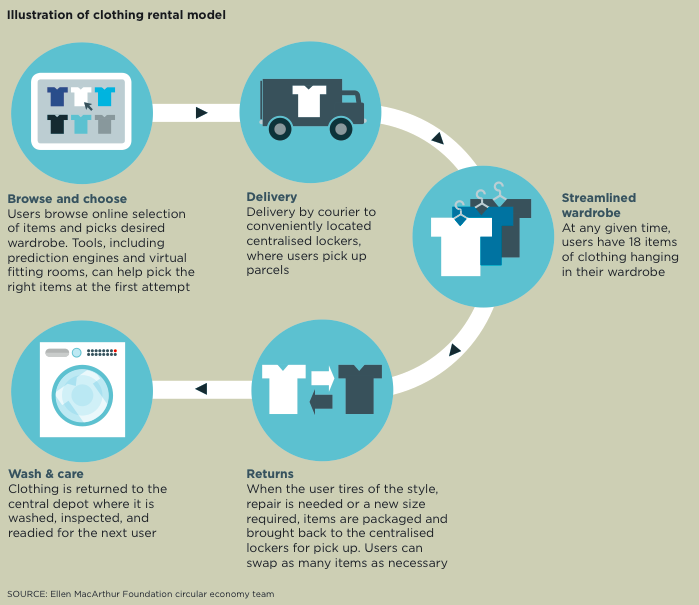Circular economy is the antonym of linear economy. Linear economy has been the dominant industrial model in our history and postulates production is followed by consumption that then ends up with the disposal of used products. As opposed to this, circular economy seeks to rebuild capital, whether this is financial, manufactured, human, social or natural and sees products having a longer or a never-ending life that are either re-used as new inputs to create new products or shared and co-owned by different consumers.
The concept of circular economy is strongly linked with issues like waste and cost of production inputs. Before anything, thinking of a circular economy means anticipating and avoiding any raw material shortcomings and price peaks and material waste.
In apparel, consumer waste accounts for 64% of the total production waste and is invariably linked to low quality of garments. Inherent low quality of garments, associated with low prices strengthens the perception of low quality and makes the discarding action easier. Shopping more and more frequently, then, becomes a natural thing to do. We know that the global apparel market, today worth $1.4 trillion and 91 billion garments sold, has dramatically expanded over the last decades. At the same time, both quality and price have fallen. The price per garment unit in the UK has decreased from £29.9/unit in 1998 to £21.5 in 2011. In 2009 Americans bought $326 billion worth of clothing using as little as 2.98% of their income, down from 4.78% in 1988, 9% in 1950 and nearly 15% in 1900. As a consequence, the quantity of waste has been increasing: it is estimated that today, in Europe and North America alone, 15 million tonnes are sent to landfill every year.
Circular business models could not only help reduce waste, hence carbon footprint, but they could also re-distribute garments that sit unused in consumers’ wardrobes becoming a potential source of economic value. In 2011 WRAP found out that the average UK household owns around £4,000 worth of clothes but around 30% is no longer used. Accessing these garments and making them available to those interested to wear them would also mean reducing industrial production and lowering resource depletion.
Ellen McArthur Foundation has recently released a report that considers the commercial opportunities that consumer goods companies could seize with new circular business models. The report presents two main business options: the first that focuses on the management of clothing end of life and the second that is about new radical collaborative consumption models.
Companies with more traditional business models take care of collecting worn out or unwanted garments and recycle them mechanically with the aim of re-using them, exporting them or turning them into cleaning rags or shreds. If sold at current prices across these usage streams, a tonne of collected and sorted clothing can generate revenues of close to $2,000. After subtraction of the costs of commercial collection and sorting of $680, the profit potential is around $1,300 per tonne. The potential revenue in a country like the U.K., where collection rates are the highest in Europe (65% of all discarded garments) would have a potential to generate $1.4 billion. Going beyond this means designing products whose materials can be easily separated and hence recyclable with chemical recycling systems like Tejin’s.
What is more interesting though is the exploration of radical new business solutions that can trigger alternative consumption models.
Fast fashion, among others, is a demand-driven phenomenon that emerged mainly to meet consumers’ desire to wear different fashionable garments all the time.
What if the same need is fulfilled renting out good quality garments rather than selling cheap ones that are meant to be bought and discarded frequently?
Assuming this is a good idea, with innovative business models it is often a problem of “how” and “why”. How to implement the new idea and why doing it? As in, will it be profitable? In Ellen McArthur Foundation’s report we find an interesting exercise that tries to show how a clothing rental service could become a profitable business to be in.

The business model is similar to that of companies like Lovefilm or Netflix: with a monthly membership and a flat fee consumers would have access to an unlimited number of garments to rent and wear. Assumptions to this model include the fact that consumers would be willing to spend on clothing rental the same amount of money (e.g. $1,000) they would spend on purchases. It is also assumed that garments can serve 75 washes that then implies that they are of better quality than the average fast fashion garment. If all assumptions are correct, this model could be more profitable than online retail with roughly $200 operating profit per renter versus $180 of a conventional online retailer. However, if production of new garments would decrease, washing of garments would increase as these would be washed after every rental before reaching the following customers. Hybrid solutions may also be possible where people are given the chance to buy and rent. Critical factors to the success of this model will include logistics to make the service easily accessible as well as convenient and marketing to make it desirable. Meanwhile, we can expect to see more studies like this in the coming months (see also WRAP’s innovative business model research) and the first initiatives and businesses launched in the next 2 to 3 years.
Have you ever thought of which market scenarios your business will find itself in the next 5, 10 or 20 years?

